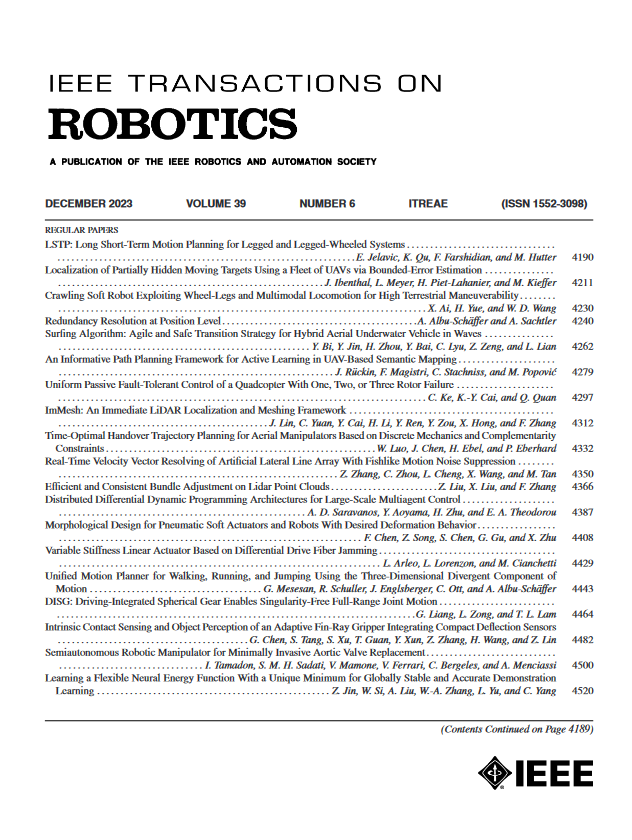仿生五自由度折纸机器人脊柱辅助外骨骼的研制
IF 9.4
1区 计算机科学
Q1 ROBOTICS
引用次数: 0
摘要
频繁和高负荷的手工材料搬运(MMH)任务经常导致工人背部受伤,背部支撑外骨骼是为从事MMH任务的个人开发的。然而,这些外骨骼通常不能很好地适应佩戴者脊柱的运动。介绍了一种新型仿生五自由度折纸,通过机械设计,提出了一种独特的刚柔耦合仿生折纸机构。该折纸机构结构紧凑、重量轻,具有稳定的运动特性。利用所设计的折纸机构,开发了一种新型的主动折纸机器人脊柱辅助外骨骼(OSAE),以帮助个人在对称和非对称举升过程中完成MMH任务。OSAE由电缆驱动模块通过由七个折纸机构组成的欠驱动脊柱模块驱动。通过设计的脊柱模块,OSAE可以很好地适应MMH任务中佩戴者的脊柱运动。对五自由度折纸进行了建模,提出了一种外骨骼自适应控制策略,以适应不同的升降方式和不同重量的物体。实验结果证明了该方法的有效性。在对称举起10公斤物体时,佩戴者腰竖脊肌(LES)的平均肌肉活动减少41.28%,在不对称举起10公斤物体时,佩戴者左右腰竖脊肌(LES)的平均肌肉活动分别减少30.15%和39.54%。本文章由计算机程序翻译,如有差异,请以英文原文为准。
Development of Bioinspired Five-DOF Origami for Robotic Spine Assistive Exoskeleton
Frequent and high-load manual material handling (MMH) tasks often cause back injuries to the workers, and back-support exoskeletons are developed for individuals with MMH tasks. However, these exoskeletons usually cannot adapt well to the movements of the wearer's spine. This article introduces a new bioinspired five degree of freedom (DOF) origami, and via mechanical design, a unique rigid-flexible coupled bioinspired origami mechanism is proposed. This origami mechanism is compact and lightweight, and it has stable kinematic behaviors. With the designed origami mechanisms, a novel active origami-based robotic spine assistive exoskeleton (OSAE) is developed to assist individuals with MMH tasks during the symmetric and asymmetric lifting. The OSAE is actuated by a cable-driven module through an underactuated spine module that consists of seven origami mechanisms. With the designed spine module, the OSAE can adapt well to the wearer's spine motions during MMH tasks. Modeling of the five-DOF origami is described, and an adaptive control strategy is proposed for the exoskeleton to adapt to different lifting methods and objects with different weights. The experimental results demonstrate the effectiveness of the proposed OSAE. During the symmetric lifting of a 10-kg object, a reduction of 41.28% of the average muscle activity of the wearer's lumbar erector spinae muscle (LES) is observed, and reductions of 30.15% and 39.54% of the average muscle activities of the wearer's left and right LES are observed, respectively, during the asymmetric lifting of a 10-kg object.
求助全文
通过发布文献求助,成功后即可免费获取论文全文。
去求助
来源期刊

IEEE Transactions on Robotics
工程技术-机器人学
CiteScore
14.90
自引率
5.10%
发文量
259
审稿时长
6.0 months
期刊介绍:
The IEEE Transactions on Robotics (T-RO) is dedicated to publishing fundamental papers covering all facets of robotics, drawing on interdisciplinary approaches from computer science, control systems, electrical engineering, mathematics, mechanical engineering, and beyond. From industrial applications to service and personal assistants, surgical operations to space, underwater, and remote exploration, robots and intelligent machines play pivotal roles across various domains, including entertainment, safety, search and rescue, military applications, agriculture, and intelligent vehicles.
Special emphasis is placed on intelligent machines and systems designed for unstructured environments, where a significant portion of the environment remains unknown and beyond direct sensing or control.
 求助内容:
求助内容: 应助结果提醒方式:
应助结果提醒方式:


